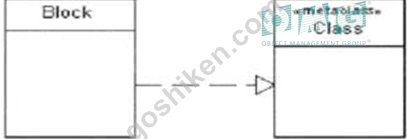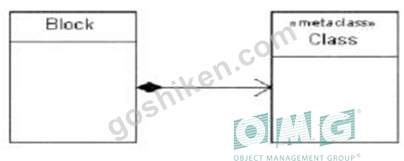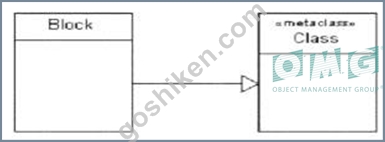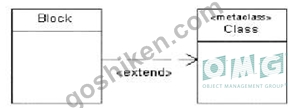100%の合格率を試そう!更新されたのはOMG-OCSMP-MBA400試験問題 [2023]
合格させるOMG-OCSMP-MBA400試験にはリアル問題解答
OMG-OCSMP-MBA400試験は、高度なシステムモデリングに関連する多肢選択問題で構成されています。これらのトピックには、モデル構築、モデル分析、モデル変換、およびモデルの検証が含まれます。この試験に合格するためには、まずOMG認定システムモデリングプロフェッショナル-モデルビルダー基礎(OMG-OCSMP-MBF200)試験に合格する必要があります。この高度な認定試験は、システムモデリング分野でキャリアを発展させ、この分野での専門知識を証明したい個人に最適です。
OMG-OCSMP-MBA400認定は、業界で高く評価され、システムモデリングの優れた証として世界的に認められています。特に、エンジニアリング、ソフトウェア開発、アーキテクチャ、プロジェクト管理などの分野で働くプロフェッショナルにとって有用です。この認定を取得することは、雇用主やクライアントに、個人が複雑なシステムのための効果的なモデルを作成することができる深い理解を持っていることを証明するものです。
質問 # 18
Choose the correct answer
Which aspect of a MBSE-based engineering project falls outside of the scope of AP233?
- A. slate machines
- B. issue management
- C. diagrams
- D. lifecycle stages
正解:C
解説:
Explanation
This aspect of a MBSE-based engineering project falls outside of the scope of AP233 because AP233 does not cover diagrams. AP233 (Application Protocol 233) is a standard that defines an information model for systems engineering. It specifies the concepts and relationships for representing systems engineering data, such as requirements, functions, properties, etc. AP233 does not define any notation or presentation for diagrams, such as SysML diagrams. AP233 only defines the serialization and deserialization of systems engineering data using XMI (XML Metadata Interchange) format. Therefore, AP233 does not address how to exchange diagrams between tools or how to visualize diagrams in different tools. References:
https://www.omg.org/ocsmp/ocsmp-adv-exam.htmhttps://www.omg.org/spec/AP233/About-AP233/
質問 # 19
Choose the correct answer
What are views and viewpoints used to show?
- A. the modeling responsibilities of different stakeholders
- B. the aspects of a model that relate to different stakeholders
- C. the aspects of a model important to users as stakeholders
- D. the system under development by the stakeholders
正解:B
解説:
Explanation
Views and viewpoints are used to show the aspects of a model that relate to different stakeholders. A view is a representation of a subset of a model that addresses a set of stakeholder concerns. A viewpoint is a specification of a perspective on a model that defines how a view should be constructed and used. By using views and viewpoints, different aspects of a model can be presented in a way that is relevant and understandable for different stakeholders. References:
https://www.omg.org/ocsmp/ocsmp-adv-exam.htmhttps://docs.nomagic.com/display/SYSMLP184/Views+and+V
質問 # 20
Choose the correct answer
How is the concept of coupling used to assess model quality?
- A. High coupling leads to poof model quality because it decreases reuse potential and prevents independent modification of system elements
- B. Low coupling leads to poor model quality because all parts of a system must be properly coupled in order to measure the completeness of the model
- C. High coupling leads to good model quality provided all blocks in a structural model exhibit the same average degree of coupling
- D. Coupling has no bearing on model quality because no metrics exist for measuring the level of coupling of SysML models
正解:A
解説:
Explanation
Coupling is a measure of how much a system element depends on other system elements. High coupling means that a change in one element affects many other elements, which makes the system harder to understand, maintain and reuse. Low coupling means that the system elements are more independent and modular, which improves the model quality. References: OMG-Certified Systems Modeling Professional - Model Builder - Advanced (OCUP2-ADV) Examination Guide Version 1.0, Section 4.1.2.2
質問 # 21
Choose the coned answer
What is the best way to ensure that a shared model has consistently-represented elements and diagrams?
- A. packages that map one-for-one to components
- B. Implementation of standard libraries
- C. modeling conventions and standards
- D. domain stereotypes maintained in a configuration control system
正解:C
解説:
Explanation
The best way to ensure that a shared model has consistently-represented elements and diagrams is to use modeling conventions and standards. Modeling conventions and standards are rules and guidelines that define how the model elements and diagrams should be named, defined, structured, formatted and documented.
Modeling conventions and standards can help improve the clarity, consistency and quality of the model and facilitate the communication and collaboration among the modelers and stakeholders. Implementation of standard libraries is a good way to ensure that a shared model has reusable and interoperable elements and diagrams, but it may not ensure their consistent representation. Packages that map one-for-one to components is a good way to ensure that a shared model has modular and traceableelements and diagrams, but it may not ensure their consistent representation. Domain stereotypes maintained in a configuration control system is a good way to ensure that a shared model has customized and controlled elements and diagrams, but it may not ensure their consistent representation. References: OMG-Certified Systems Modeling Professional - Model Builder - Advanced (OCUP2-ADV) Examination Guide Version 1.0, Section 4.1
質問 # 22
Choose the correct answer
In addition to selecting the methodology activities to be performed, what other tailoring does the systems modeling team need to consider when defining the project methodology?
- A. which artifacts need to be produced when executing the tailored activities
- B. which activities will interact with external systems
- C. which kind of diagrams will be used to create the domain model
- D. which requirements will be allocated to the specialty engineering activities
正解:A
解説:
Explanation
An artifact is a tangible or intangible product or outcome of an activity or process. Examples of artifacts include models, diagrams, documents, reports, etc. When defining the project methodology, the systems modeling team needs to consider which artifacts need to be produced when executing the tailored activities, because this determines what information needs to be captured, communicated, and delivered throughout the project lifecycle. The artifacts should be aligned with the project objectives, scope, deliverables, and quality standards
質問 # 23
Choose the correct answer.
What is common practice when integrating software models into SysML system models?
- A. The software is specified with UML in the SysML system model
- B. Cross-relationships are defined between a UML software model and a SysML system model
- C. The software is specified with SysML in the SysML system model.
- D. A model-to-model transformation integrates a UML software model into a SysML system model
正解:B
解説:
Explanation
The common practice when integrating software models into SysML system models is to define cross-relationships between a UML software model and a SysML system model. A cross-relationship is a dependency that indicates a link between elements in different models or domains. By using cross-relationships, one can establish traceability and consistency between the software model and the system model without having to merge or transform them. Cross-relationships can also support allocation of software components to hardware or other software components in the system model. References:
https://www.omg.org/ocsmp/ocsmp-adv-exam.htmhttps://www.ibm.com/docs/bg/rhapsody/8.3.1?topic=function
質問 # 24
Choose the correct answer.
What is a common rationale for defining and applying a profile to a SysML model?
- A. The profile enables separate views of the model for the different stakeholder concerns.
- B. The profile makes the model suitable for a modeling tool
- C. The profile extends the model with reusable elements, e.g. units.
- D. The profile adds appropriate metainformation to the model to allow automated system analysis
正解:C
解説:
Explanation
A common rationale for defining and applying a profile to a SysML model is that the profile extends the model with reusable elements, such as units, quantities, value types, etc. These elements can be defined in a model library and imported into other models by applying the profile. This way, the profile enables consistent and standardized modeling of properties and parameters of blocks and constraints. References:
https://www.omg.org/ocsmp/ocsmp-adv-exam.htmhttps://github.com/Systems-Modeling/SysML-v2-Release
質問 # 25
Choose the correct answer
What is the key distinction between SysML modeling and MOF modeling?
- A. MOF models are intended to be strictly models of abstract entities SysML models represent real world entities and processes
- B. MOF models are used for domain-independent modeling SysML models are used for domain-specific modeling.
- C. MOF models are intended to be models of modeling constructs SysML models represent real world entities and processes.
- D. They both have the same purpose except that MOF modeling is intended for specialized and advanced usage by systems architects
正解:C
解説:
Explanation
MOF stands for Meta-Object Facility, which is a standard for defining metamodels. Metamodels are models of modeling constructs, such as classes, attributes, associations, etc. SysML stands for Systems Modeling Language, which is a standard for modeling complex systems using diagrams and textual notations. SysML models represent real world entities and processes, such as components, behaviors, requirements, etc. The key distinction between SysML modeling and MOF modeling is that SysML models are instances of a metamodel defined by MOF. References: https://www.omg.org/ocsmp/ocsmp-adv-exam.htm
https://www.omg.org/mof/https://www.omg.org/sysml/
質問 # 26
Choose the coned answer.
A department director is responsible (or monitoring the system development processes in a large systems engineering company. In a few systems engineering projects, irritation developed recently between the specialists department's requirements analysts and the system engineering design team, although the methodology had been introduced a couple of years ago.
How could the director resolve this conflict?
- A. Tell the teams' supervisors to encourage better teamwork, and check every other week to see how the teams have improved
- B. Let each team decide on its individual development methodology. The teams' supervisors will have to budge gaps where they occur
- C. Note if the systems engineering methodology still works with the company's business processes, and make modifications where needed
- D. Repeat the methodology training tor the people involved and check every other week to see if the methodology usage by the teams is improving
正解:C
解説:
Explanation
A systems engineering methodology is a collection of related processes, methods, and tools that support the discipline of systems engineering in a specific context. A systems engineering methodology should be aligned with the company's business processes and goals, and should be updated and improved as needed to reflect changes in the environment, technology, customer needs, etc. By noting if the systems engineering methodology still works with the company's business processes, and making modifications where needed, the director canresolve the conflict between the requirements analysts and the system engineering design team by ensuring that they follow a consistent and effective approach to systems engineering
質問 # 27
Choose the correct answer.
A model is being built using constructs defined in a Quality profile Project requirements state that the model must only be built using the constructs defined In the Quality profile - no other metaclasses may be used.
Which diagram fragment correctly expresses this requirement?
- A.

- B.

- C.

- D.

正解:C
解説:
Explanation
The diagram fragment that correctly expresses the requirement that the model must only be built using the constructs defined in the Quality profile is Option C.
This option shows an "apply" relationship between the model and the profile with the {strict} keyword applied. This means that only elements with stereotypes from the Quality profile can be created as instances of the extended metaclasses. References:
https://www.omg.org/ocsmp/ocsmp-adv-exam.htmhttps://www.ibm.com/docs/SSB2MU_8.2.0/com.ibm.rhp.sysm
質問 # 28
Choose the correct answer
A stereotype is defined in a profile This stereotype has two properties whose types were already defined in the model What must be done to reuse their type definitions?
- A. The package defining the types needs to import the profile
- B. The profile needs to import the package where these types are defined.
- C. The profile needs to apply the package where these types are defined.
- D. The package defining the types needs to apply the profile.
正解:B
解説:
Explanation
To reuse the type definitions of the properties of a stereotype, the profile needs to import the package where these types are defined. An import relationship indicates that the elements in one package can be referenced by another package without a qualified name. By importing the package with the types, the profile can use them as attributes of the stereotype without having to redefine them. References:
https://www.omg.org/ocsmp/ocsmp-adv-exam.htmhttps://www.ibm.com/docs/SSB2MU_8.2.0/com.ibm.rhp.sysm
質問 # 29
Choose the correct answer
If a systems modeling tool conforms to the XMI specification and includes the XMI representation of the UML Profile for SysML and the XMI representations of Model Libraries defined by SysML. what does the tool provide?
- A. the import and export of only SysML model data from one tool to another
- B. the import and export of only SysML diagrams from one tool to another
- C. the ability to perform model checking to verify model conformance
- D. the import and export of both SysML diagrams and model data from one tool to another
正解:D
解説:
Explanation
If a systems modeling tool conforms to the XMI specification and includes the XMI representation of the UML Profile for SysML and the XMI representations of Model Libraries defined by SysML, the tool provides the import and export of both SysML diagrams and model data from one tool to another. XMI (XML Metadata Interchange) is a format specification that enables the interchange of objects and models through an XML formatted file. It is based on a metamodel that defines the abstract syntax and semantics of the model elements. By conforming to the XMI specification, a tool can serialize and deserialize SysML models in terms of XML elements and attributes. The tool can also include the XMI representation of the UML Profile for SysML, which defines the mapping of SysML concepts to UML concepts, and the XMI representations of Model Libraries defined by SysML, which provide predefined types and units for SysML models. This way, the tool can import and export both SysML diagrams and model data from one tool to another, ensuring consistency and interoperability. References:
https://www.omg.org/ocsmp/ocsmp-adv-exam.htmhttps://www.omg.org/spec/XMI/2.5.1/About-XMI/
質問 # 30
Choose the correct answer.
Which diagram fragment correctly a SysML Block extending a basic UM Class?
A)
B)
C)
D)
E)
- A. Option D
- B. Option C
- C. Option A
- D. Option B
正解:D
解説:
Explanation
The diagram fragment that correctly shows a SysML Block extending a basic UML Class is Option B.
This option shows a Block with the stereotype <<block>> applied to it. This stereotype indicates that the Block is an extension of the Class metaclass. The Block inherits all the features of the Class, such as attributes, operations, associations, etc., and adds additional features specific to SysML, such as ports, flows, values, constraints, etc. References:
https://www.omg.org/ocsmp/ocsmp-adv-exam.htmhttps://sysml.org/sysml-faq/what-is-block-definition-diagram.
質問 # 31
Choose the correct answer
What happens to the elements of a model when a profile is applied to the model?
- A. The stereotypes defined in the profile are available to be applied to any element in the model.
- B. The stereotypes defined in the profile may be applied to elements sharing compatible metaclasses
- C. The stereotypes defined in the profile are applied to the model's metamodel elements
- D. The stereotypes defined in the profile ate automatically applied lo the elements sharing compatible metaclasses
正解:B
解説:
Explanation
A profile is a mechanism for extending the UML or SysML metamodel with domain-specific concepts. A profile defines stereotypes, which are extensions of existing metaclasses. A metaclass is a modeling construct that defines the properties and behavior of a set of model elements. For example, the metaclass Class defines the properties and behavior of all classes in a model. When a profile is applied to a model, the stereotypes defined in the profile may beapplied to elements sharing compatible metaclasses. For example, if a profile defines a stereotype <<device>> as an extension of the metaclass Class, then the stereotype <<device>> may be applied to any class in the model. References: https://www.omg.org/ocsmp/ocsmp-adv-exam.htm
https://www.omg.org/spec/UML/About-UML/https://www.omg.org/spec/SysML/About-SysML/
質問 # 32
Choose the correct answer
What does a model library add to a SysML model?
- A. common concepts
- B. stereotypes
- C. methodology-specific modeling concepts
- D. domain-specific modeling concepts
正解:A
解説:
Explanation
A model library is a package that contains reusable model elements that can be imported into other models. A model library can add common concepts to a SysML model, such as units, quantities, value types, etc. These concepts can be used to define properties and parameters of blocks and constraints in a consistent and standardized way. References:
https://www.omg.org/ocsmp/ocsmp-adv-exam.htmhttps://www.omg.org/spec/SysML/1.6/PDF
質問 # 33
Choose the correct answer
A systems engineer is establishing a viewpoint whose purpose is to support performance analysis.
Which combination of SysML diagram types would the engineer be most likely to choose for the viewpoint languages?
- A. use case and requirements diagrams
- B. parametric and activity diagrams
- C. sequence and state diagrams
- D. block definition and package diagrams
正解:B
解説:
Explanation
Parametric and activity diagrams are suitable for performance analysis because they can capture the quantitative aspects of a system, such as parameters, constraints, equations, values, units, flows and rates.
Sequence and state diagrams are more focused on the temporal and behavioral aspects of a system, such as interactions, events and states. Use case and requirements diagrams are more focused on the functional and non-functional aspects of a system, such as actors, scenarios and goals. Block definition and package diagrams are more focused on the structural and organizational aspects of a system, such as blocks, parts, ports, connectors and packages. References: OMG-Certified Systems Modeling Professional - Model Builder - Advanced (OCUP2-ADV) Examination Guide Version 1.0, Section 4.4.1
質問 # 34
......
OMG-OCSMP-MBA400試験は、システムモデリングにおける候補者の知識とスキルを厳密に試験するものです。この試験は、100問の多肢選択問題から構成され、受験者は3時間以内に回答する必要があります。問題は、実世界のシナリオやプロジェクトに自身の知識を適用できるかどうかを試験するよう設計されています。システムアーキテクチャ、要件管理、行動モデリング、パラメトリックモデリングなど、幅広いトピックが試験範囲に含まれます。この試験に合格することで、候補者のシステムモデリングにおける専門知識が証明され、その分野でのキャリアアップが促進されるでしょう。
OMG-OCSMP-MBA400試験問題を最新版を今すぐ試そうの[2023年最新] 正解回答付き:https://www.goshiken.com/OMG/OMG-OCSMP-MBA400-mondaishu.html
